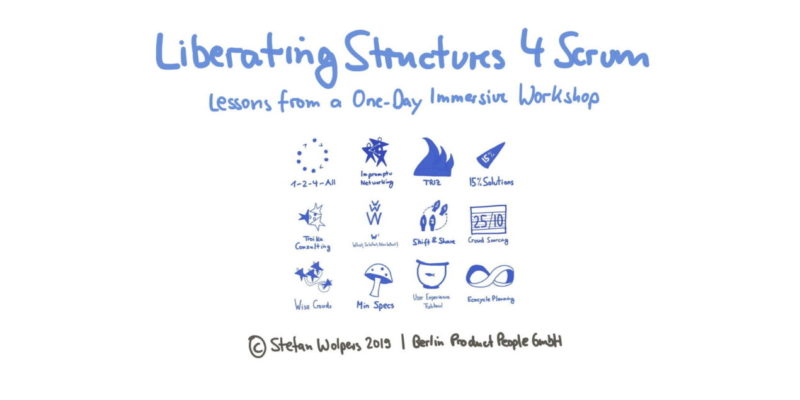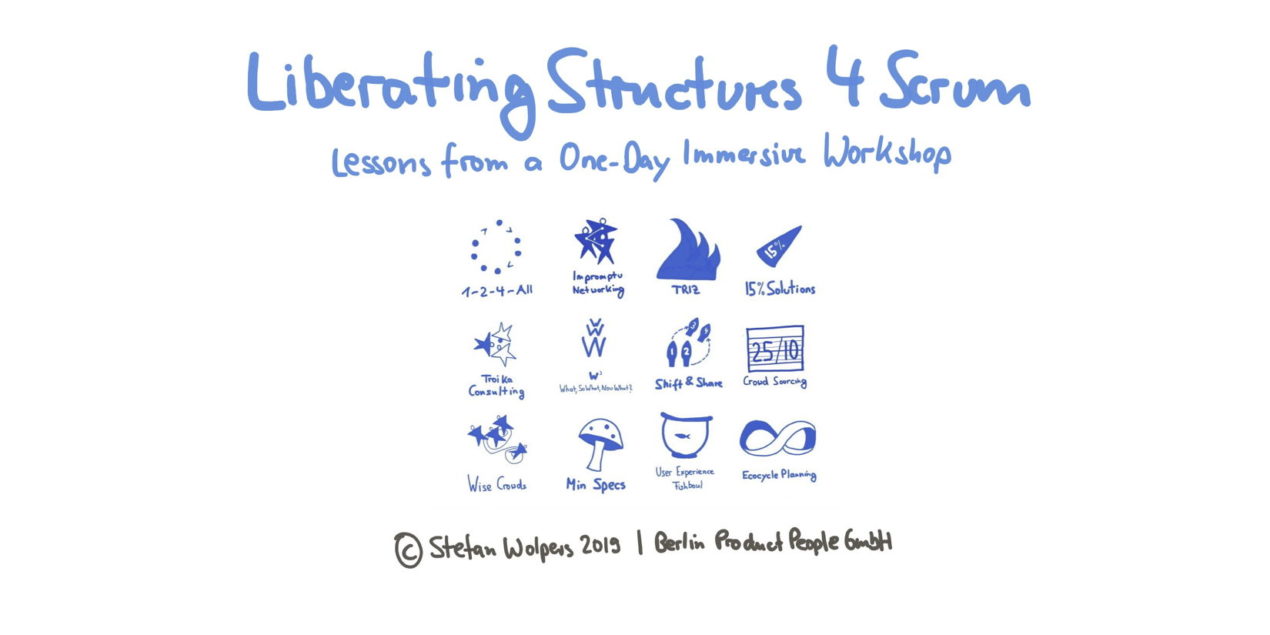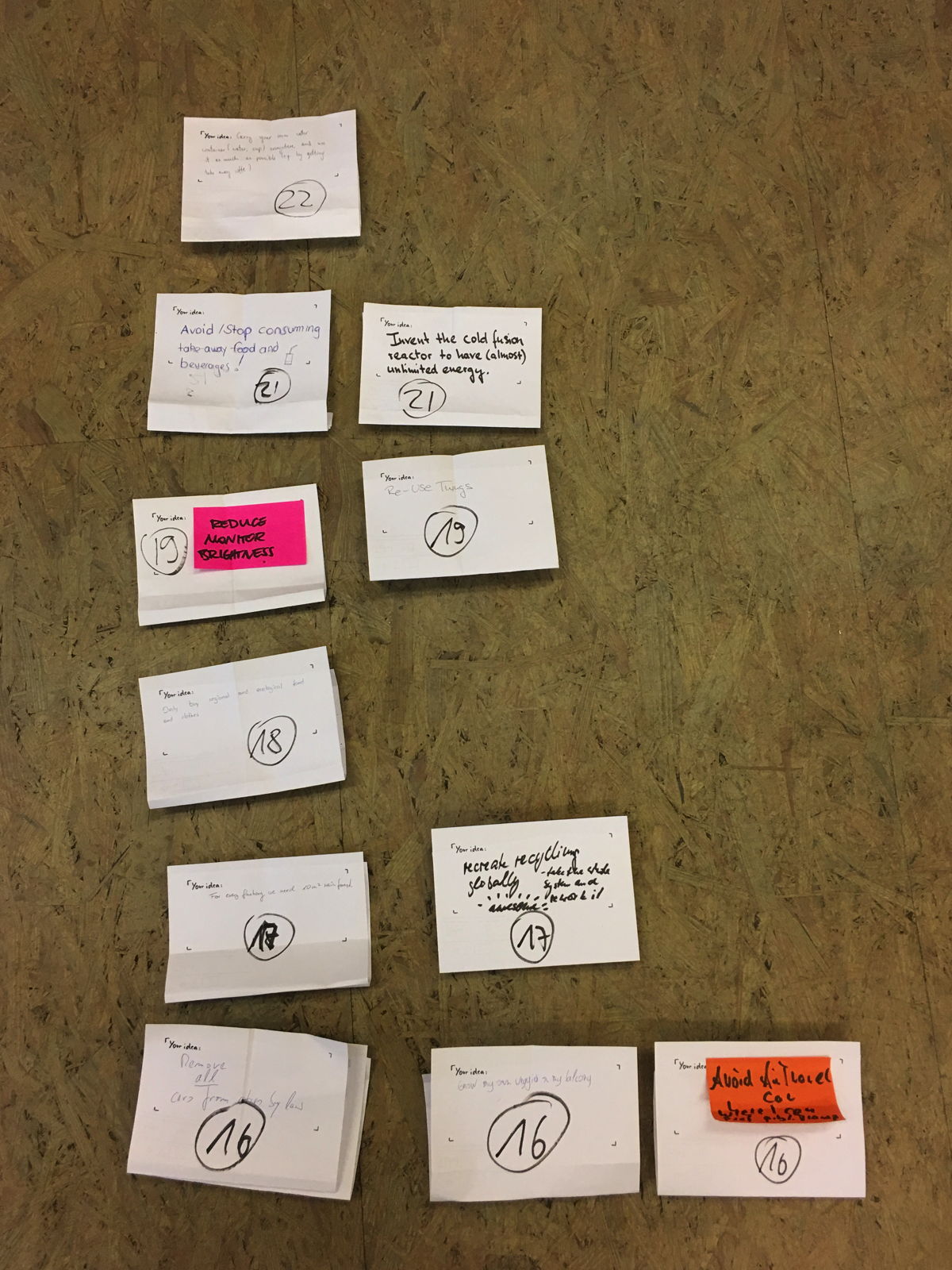TL; DR: The Liberating Structures Immersive Workshop for Scrum
Why running a Liberating Structures immersive workshop? Since the beginning of 2019, the Hands-on Agile meetup in Berlin has been exploring how to apply Liberating Structures to Scrum. Beyond the basics, we have addressed the Sprint Retrospective, the Sprint Planning, the Product Backlog as well as the Daily Scrum.
While the initial meetups went smoothly, the last two meetups felt rushed given that we usually have about two hours. Also, the changing composition of the meetup attendees has become more challenging; less than 10 percent of the approximately 150 participants so far have attended meetups.
So, I thought it might be a worthwhile experiment to aggregate the previous meetups into a one-day immersive workshop on Liberating Structures for Scrum, built around climate change and MegaBrain.io, a struggling startup with little runway left and in desperate need of two successful Sprints. We ran that workshop last week, and this is what we learned.
🗞 Do you want to get this article in your inbox in the future? You can sign up here for our weekly ‘Food of Agile Thought newsletter’ and join 29k other subscribers.
Concept of the Immersive Workshop
The Liberating Structures Workshop for Scrum — From Daily Scrum to Sprint Review took place on July 6th, 2019, at the Alte Kantine Wedding, an ample converted industrial space in Berlin. All in all, 30 people attended the workshop, which was scheduled from 9:00 am to 5:30 pm. I estimate the net time available for the workshop to be around 6.5 hours.
I designed the workshop as an analog experience: no electronic devices were needed, just paper, stickies, and markers — a 32-pages workbook provided to each attendee all information for the exercises. This journal also provided an opportunity to take notes, make sketches, and record observations and feelings — thus creating a bond between the attendee and Liberating Structures as a concept. The workbook lists twelve LS microstructures ordered according to the LS Menu. However, we used them in different flow during the workshop.
Finding Common Ground: Climate Change
Working through a set of LS microstructures is straight forward when everyone belongs to the same organization as all then have a shared understanding of the culture and issues at hands. In our case, that was a challenge given that the attendees belonged to at least 25 different organizations. At the Hands-on Agile meetups before, we tried as a common theme everyone can relate to Berlin’s public transport system. It worked reasonably well; however, the topic does not leave much room for the decisions of an individual.
Therefore, I tried a different topic for the workshop that is less abstract and has a much more personal component: climate change. Two days before the workshop, I asked participants to brush up their knowledge on the topic, providing some links to relevant sites:
- NASA — Global Climate Change.
- NASA — Global Climate Change, Evidence.
- Wikipedia on Climate Change.
- Bonn Climate Change Conference — June 2019.
- United Nations Environmental Programme — Climate Change.
- nature climate change.
The Liberating Structures Immersive Workshop — The First Run
The workshop started with a string of exercises based on different LS microstructures, partly nesting them, and ended with two exercises building on top of the MegaBrain.io scenario — a struggling startup undertaking a last ditch effort to secure another funding round. At least that was the initial plan. It turned out that we had to skip more LS microstructure than the two anticipated, and that we could only deliver on one of the two exercises.
Liberating Structures Microstructures Used
- We started with Impromptu Networking, addressing a personal challenge each attendee faces in her organization.
- We followed up on the previous challenge from Impromptu Networking with Troika Consulting. (There is a chance that someone might gain new insights into how to solve the challenge at hand this way.)
- We then left the individual challenges and moved as a group to climate change by analyzing the current situation using TRIZ. (We formed four sub-groups and used 1-2-4-All to aggregate the findings. Each sub-group then shared its outcome with the whole group with Shift & Share.)
- Next, we used the outcome from TRIZ to run 15% Solutions on top. (Again, we used 1-2-4-All to aggregate and Shift & Share to share the outcomes with the whole group.)
- Then we delved into 25/10 Crowd Sourcing to identify the most tolerable solutions to fight climate change.
- We intentionally skipped What, So What, Now What? and Wise Crowds.
- Due to time constraints, we also had to skip Min Specs and the User Experience Fishbowl.
- Instead, we went directly to Ecocycle Planning, thus completing the LS microstructure part of the workshop.
The MegaBrain.io Scenario
The next part of the Liberating Structures immersive workshop comprised of the two MegaBrain-io exercises. This is the scenario:
A year ago, MegaBrain.io was a well-funded, Berlin-based hopeful in the race to improve schooling by creating tailored curricula for each student derived from an AI.
Today, MegaBrain.io’s situation is dire:
- Only three months of runway left.
- Conflicts among the founders, as well as between Product and Engineering, become more frequent as well as more public.
- The existing VCs are not pleased with the growth metrics for the last nine months and hence are reluctant to provide more capital to MegaBrain.io.
- However, there is a newly formed VC interested in investing—provided MegaBrain.io delivers the much anticipated yet overdue 3.0 release.
- In a last-ditch effort, the management fired 32 people mainly from marketing, sales, and administration last week to save liquidity to bring this new investor onboard—that was a third of the team.
- The previous Sprint was a disaster. For the third time in a row, MegaBrain.io’s three Scrum Teams failed to deliver the 3.0 release.
- The current Sprint—ending in a week from now—looks more promising.
- All hopes now rest on the upcoming two Sprints to finally deliver the 3.0 release and to make the miracle of a new investment happen.
Originally, the group was tasked with two exercises:
Task #1: The Sprint Review
Your first task is to suggest a Sprint Review format that ensures that the three Scrum Teams can go into the upcoming Sprint with the best possible Product Backlog.
Start as individuals, then form four small groups of approximately equal size. Use Shift & Share with the whole group at the end to present each small group’s finding.
Phases:
- ⏰ Individual phase: 5 minutes.
- ⏰ Small group phase: 25 minutes.
- ⏰ Whole group phase: 15 minutes.
Task #2: The Sprint Retrospective
Your second task is to suggest a Retrospective format with an extended circle of attendees to ensure that MegaBrain.io will not waste the two critical upcoming Sprints.
Given the all-hands-to-deck situation, the Retrospective shall include the Scrum Team members, the Product and Engineering leads, the key stakeholders as well as the two founders.
Start as individuals, then form four small groups of approximately equal size. Use Shift & Share with the whole group at the end to present each small group’s finding.
Phases:
- ⏰ Individual phase: 5 minutes.
- ⏰ Small group phase: 25 minutes.
- ⏰ Whole group phase: 15 minutes.
However, the group favored an extended discussion of the proposed Sprint Review approaches instead of running the second exercise. So, we skipped the Sprint Retrospective exercises and finished in time.
Liberating Structures Immersive Workshop — The Conclusion
The workshop turned out to be an inspiring experience despite being a bit bumpy here and there — it was the first I ran this workshop concept. Six attendees have so far provided feedback, mentioning that the schedule was too ambitious for one day, that timeboxing needs to be rigorously enforced, that different experience levels need to be addressed, and that weaving LS strings should start earlier. Nevertheless, the NPS of the experiment is 83 at the moment.
What changes are planned? The next iteration will look as follows:
- Task #1 — the Sprint Review — as well as the User Experience Fishbowl and the Ecocycle Planning are removed.
- Instead, all three become part of another experiment: A Liberating Structures for Scrum workshop on getting the “product part” right, from Sprint Review to Product Backlog refinement, to product roadmap planning. The trial run of this new workshop will happen on September 7, 2019, at the Alte Kantine Wedding. Stay tuned!
If you like to experience the next iteration of this Liberating Structures workshop consider joining me on September 17-19, 2019, in Berlin for the Professional Scrum Master Training PSM I + Liberating Structures.
Attribution
Liberating Structures are developed by Henri Lipmanowicz and Keith McCandless and are licensed under a Creative Commons Attribution-NonCommercial 4.0 International License.
📖 Liberating Structures Immersive Workshop — Related Posts
Liberating Structures for Scrum (1): The Sprint Retrospective.
Liberating Structures for Scrum (2): The Sprint Planning.
📅 Scrum Training Classes, Workshops, and Events
You can secure your seat for Scrum training classes, workshops, and meetups directly by following the corresponding link in the table below:
See all upcoming classes here.
You can book your seat for the training directly by following the corresponding links to the ticket shop. If the procurement process of your organization requires a different purchasing process, please contact Berlin Product People GmbH directly.
✋ Do Not Miss Out and Learn more about Liberating Structures: Join the 12,000-plus Strong ‘Hands-on Agile’ Slack Team
I invite you to join the “Hands-on Agile” Slack team and enjoy the benefits of a fast-growing, vibrant community of agile practitioners from around the world.
If you like to join now all you have to do now is provide your credentials via this Google form, and I will sign you up. By the way, it’s free.








